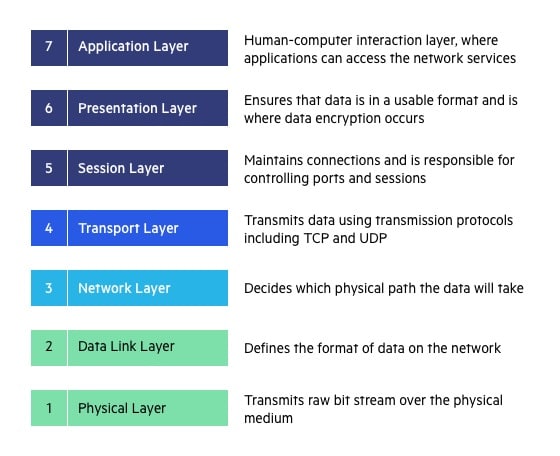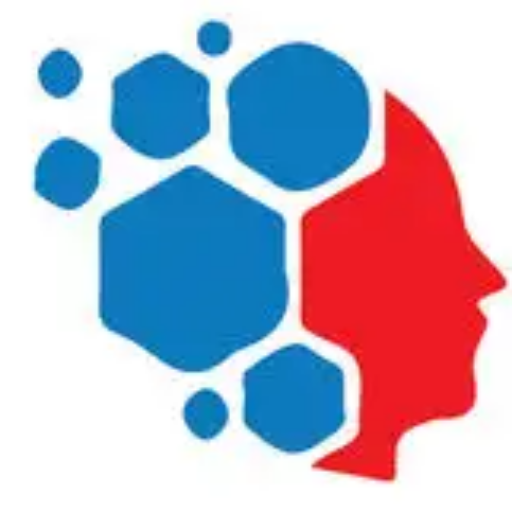
What is OSI Model? #
The first step in becoming a network professional is by learning the 7 layers of the OSI Model and their functions. The OSI Model is like a blueprint for how different computer systems can talk to each other over a network. It breaks down all the different steps that happen when you send a message or a piece of information from one device to another.
Think of it like a recipe for making a cake. Just like how you need flour, sugar, and eggs to make a cake, computer systems need different layers of communication to send and receive information. The OSI Model has 7 layers, each with a specific job to do.
The Physical layer in the OSI model #
Starting from the bottom, the first layer is the Physical Layer, which deals with the actual cables and wires that connect devices together. The Physical layer of the OSI Model is like the foundation of network communication. It’s responsible for transmitting the raw bits of data over the physical medium. Think of it like the roads on which your car travels to reach its destination.
The Physical layer is where we find protocols that are responsible for the physical connection between devices. This includes things like the type of cable or wire used, the type of connector, and the type of signal that is used to transmit the data.
For example, the Ethernet protocol is a physical layer protocol that is used to transmit data over a wired network. It defines things like the type of cable that is used (such as twisted-pair or fiber optic), the type of connector (such as RJ-45), and the type of signal that is used to transmit the data (such as electrical signals).
Another example is the Wi-Fi protocol, which is used to transmit data wirelessly. It defines the type of radio frequency that is used to transmit the data, the type of antenna that is used, and the type of modulation that is used to encode the data onto the radio frequency.
The Data Link Layer of the OSI Model #
The second layer is the Data Link Layer, which makes sure that the information is sent in the right order and doesn’t get mixed up. The Data Link layer of the OSI Model is like the traffic cop of the network communication. It’s responsible for breaking the data into small chunks called data frames and making sure that they are delivered to the right place.
Imagine you’re sending a package to your friend via a delivery service. The Data Link layer would be the person who makes sure that the package is properly wrapped, labeled, and sent to the right address, and that it gets there in one piece.
The Data Link layer is where we find protocols like the Ethernet protocol and the ARP (Address Resolution Protocol). The Ethernet protocol is responsible for breaking the data into small chunks called packets, and making sure that they are delivered to the right place. The ARP protocol helps to match the IP address of a device to its physical address on the network.
Another function of the Data Link layer is to provide error checking and correction. This ensures that the data is being transmitted correctly, and if there are any errors, they will correct them.
The Network Layer of the OSI Model #
As we move up the layers, we get to the Network Layer, which is responsible for making sure that the information gets to the right place. The Network layer of the OSI Model is like the GPS of the network communication. It’s responsible for routing the packets of data to their destination, making sure they reach the right place.
Imagine you’re trying to get to a new place, you are using GPS on your phone to navigate and reach your destination. The Network layer would be the part of the GPS that calculates the best route to your destination, taking into account traffic, road closures, and other factors to make sure you get there as quickly and efficiently as possible.
The Network layer is where we find protocols like the IP (Internet Protocol) and ICMP (Internet Control Message Protocol). The IP protocol is responsible for routing the packets of data to their destination, using the IP addresses of devices on the network. The ICMP protocol is used to help troubleshoot and diagnose network problems.
Another function of the Network layer is to provide logical addressing, which helps devices on the network to communicate with each other, even if they are located in different parts of the world.
The Transport Layer of the OSI Model #
The fourth layer is the Transport Layer, which makes sure that the information gets to the right person or device. The Transport layer of the OSI Model is like the personal delivery service of network communication. It’s responsible for making sure that the packets of data are delivered to the right person or device, and that they arrive in the right order.
Imagine you’re ordering something online, and you want to make sure that it gets to your house. The Transport layer would be the person who double-checks the address and makes sure that the package is delivered to the right person at your house, and that all the items in the package arrive in the right order.
The Transport layer is where we find protocols like the TCP (Transmission Control Protocol) and UDP (User Datagram Protocol). The TCP protocol is responsible for making sure that the packets of data are delivered to the right person or device, and that they arrive in the right order. The UDP protocol is a simpler protocol that is used for applications that don’t require the level of reliability provided by TCP.
Another function of the Transport layer is to provide flow control, which helps to prevent data overload and ensures that the data is transmitted at a rate that the receiving device can handle.
The Session Layer of the OSI Model #
The fifth layer is the Session Layer, which helps to establish and maintain connections between devices. The Session layer of the OSI Model is like the organizer of network communication. It’s responsible for setting up, managing, and tearing down connections between devices on a network.
Imagine you’re throwing a party and you want to invite your friends over. The Session layer would be the person who makes sure that everyone has a good time, that they are talking to the right people, and that they are leaving at the right time.
The Session layer is where we find protocols like the RPC (Remote Procedure Call) protocol. This protocol sets up, manages, and tears down connections between devices on a network, allowing them to communicate with each other. It’s like an organizer that schedules appointments between devices, ensuring that they can talk to each other efficiently.
Another function of the session layer is to allow multiple conversations to take place simultaneously, like at a party where different groups of people can have different conversations at the same time.
The Presentation Layer of the OSI Model #
The sixth layer is the Presentation Layer, which deals with how the information is displayed or presented to the user. The Presentation Layer of the OSI Model is like the translator of network communication. It’s responsible for converting the data into a format that can be understood by the different devices on the network.
Imagine you’re trying to show a movie to your friends, but they all speak different languages. The presentation layer would be the person who translates the movie into all the different languages so that everyone can understand it.
The presentation layer is where we find protocols like ASCII (American Standard Code for Information Interchange) and JPEG (Joint Photographic Experts Group). These protocols translate data into a format that can be understood by different devices.
For example, ASCII is a protocol that is used to represent text characters (letters, numbers, symbols) in a way that computers can understand. It’s like a code that allows computers to read and write text. JPEG is a protocol that is used to compress and decompress images so that they can be transmitted over a network more efficiently.
Another function of the presentation layer is to encrypt the data for security purposes. For example, the SSL (Secure Sockets Layer) and TLS (Transport Layer Security) protocols can be used to encrypt data so that it can only be read by the intended recipient.
In summary, the presentation layer is responsible for converting the data into a format that can be understood by the different devices on the network. It’s like a translator that makes sure everyone is on the same page. Protocols like ASCII, JPEG, SSL, and TLS operate in this layer. These protocols translate, compress, decompress, and encrypt the data.
The Application Layer of the OSI Model #
And finally, the seventh layer is the Application Layer, which is the layer which the user interacts directly with. The Application layer of the OSI Model is the topmost layer and it’s the one that users interact with directly. It’s like the steering wheel of network communication. This layer is responsible for providing the interface between the user and the network.
The application layer is where we find the programs and apps that we use every day to access the internet, such as web browsers, email programs, and instant messaging apps. These programs use specific protocols to communicate with other devices on the network and get the information we need.
For example, when you use a web browser to access a website, the browser uses the HTTP (Hypertext Transfer Protocol) to communicate with the server where the website is hosted. HTTP is a protocol that is used to transfer data over the web, and it’s one of the many protocols that operate at the application layer. Other protocols that operate at this layer are FTP (File Transfer Protocol), SMTP (Simple Mail Transfer Protocol), Telnet, DNS (Domain Name System), SNMP (Simple Network Management Protocol), and DHCP (Dynamic Host Configuration Protocol).
Another function of the application layer is to provide security and authentication. When you enter your username and password to log in to a website or an app, the application layer uses protocols like SSL (Secure Sockets Layer) or TLS (Transport Layer Security) to encrypt the information and ensure that it can only be read by the intended recipient.
How to Remember the 7 layers of the OSI Model and their functions #
You need to master the following mnemonic to remember the 7 layers of the OSI Model and their functions. You can use the bottom-up or top-down approach to remember the layers
Mnemonic (Read From Top)
All
People
Seem
To
Need
Data
Processing
OSI Layer
Application Layer
Presentation Layer
Session Layer
Transport Layer
Network Layer
Data Link Layer
Physical Layer
Mnemonic (Read from Bottom)
Away
Pizzas
Sausages
Throw
Not
Do
Please
The OSI Model is a valuable tool for comprehending how various components of a computer network collaborate to transmit and receive data. It enables network engineers and administrators to diagnose issues and ensure their networks operate efficiently. Although the OSI Model is a theoretical model, it’s not always strictly implemented in real-world networks. Some protocols and technologies may overlap multiple layers or not fit precisely into one layer. Nevertheless, it still provides useful insights into how networks function. Additionally, it’s important to note that the OSI model is not exclusive to computer networks and is also applicable to other communication technologies.




